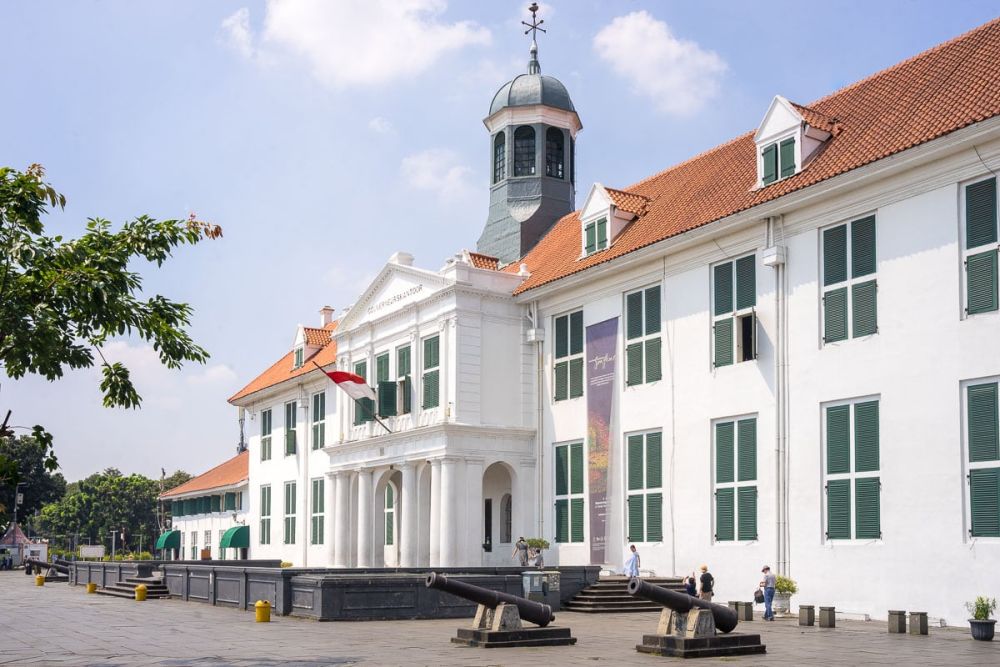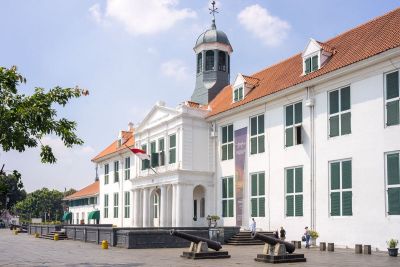

Fatahillah Square, also known as Taman Fatahillah, is the historical center of the Kota Tua area. Surrounded by colonial buildings influenced by Dutch architecture, the square is a bustling hub of activity where visitors can immerse themselves in the area's rich history. The cobblestone plaza is often filled with street performers, food vendors, and artists. Museums such as the Jakarta History Museum, Wayang Museum, and the Fine Art and Ceramic Museum offer insights into the city's past. Tourists can rent colorful bicycles and ride around the square, making for a picturesque and enjoyable experience.
The Jakarta History Museum, located at the north side of Fatahillah Square, is housed in the former City Hall of Batavia. With an extensive collection of artifacts, including furniture and maps, the museum provides a fascinating look at Jakarta's colonial history under Dutch rule. Visitors can explore over 23,500 objects that tell the story of Jakarta from prehistoric times to independence. The building itself is a historical masterpiece, featuring architecture from the 17th century with well-preserved courtrooms and jail cells that echo the tales of a bygone era.
Just a stone's throw away from Fatahillah Square is the Wayang Museum, a unique institution dedicated to the traditional art of Javanese puppetry, known as 'wayang.' The museum boasts an impressive display of wayang puppets from various regions of Indonesia, as well as collections from other countries like China and India. Visitors can learn about the history, philosophy, and production of these cultural artifacts. The museum occasionally hosts live puppet shows, offering a chance to witness the mesmerizing performances first-hand. It's a must-visit for anyone interested in the performing arts and Indonesian culture.
Housed in a building that was once the Court of Justice of Batavia, the Fine Art and Ceramic Museum showcases a diverse range of Indonesian fine art and ceramics. The expansive collection showcases traditional and contemporary paintings, sculptures, and ceramics that highlight the country's artistic evolution. Visitors can appreciate the work of prominent artists, as well as learn about the ceramic-making process and its historical significance in Indonesia. This museum provides not only a visual treat but also rich insights into the country's cultural and artistic heritage.
The Bank Indonesia Museum offers an informative journey through the nation's financial history, with well-crafted exhibits on currency, banking activities, and economic policies. Interactive displays and multimedia presentations make the experience engaging for visitors of all ages. The museum is housed within a beautifully restored heritage building, showcasing neoclassical architectural elements which are a feast for the eyes. The tour provides a greater understanding of how Indonesia's economy has evolved over time and the role of the central bank in shaping the country's monetary landscape.
Located near the famous Sunda Kelapa Harbor, the Maritime Museum delves into Indonesia’s rich maritime history, emphasizing the importance of the archipelago's seas in global trade. It is situated in restored Dutch East Indies warehouses which add to the authenticity of the experience. The museum displays models of ships from different eras, maritime equipment, and historical maps. You'll be able to explore Indonesia's journey from the spice trade era to its contemporary status in marine trade and the significance of naval advancement in Indonesian history.
A guided walking tour of Kota Tua is a wonderful way to gain in-depth knowledge about the history and culture of Old Town Jakarta. These tours are generally led by knowledgeable local guides who can provide fascinating insights and stories about the colonial-era buildings, landmarks, and their role in Indonesia's history. As you wander the cobbled streets, you'll visit key spots such as Fatahillah Square, Toko Merah, and the old ports. This cultural walk is not only educational but also offers many picture-perfect moments.
One of the most charming ways to explore Kota Tua is by renting a colorful bicycle. Bicycles are available for rent at several locations around Fatahillah Square. Riding these bikes, often adorned with vibrant flowers and flags, allows for a leisurely tour of the area's attractions. You can either follow your curiosity around the Old Town’s landmarks or join a cycling group for a guided experience. Bicycle rentals are an affordable and fun activity suitable for all ages and offer a refreshing break from walking.
Café Batavia is a landmark eatery situated in a colonial building overlooking Fatahillah Square. The cafe oozes old-world charm with its vintage decor, antique furnishings, and historical photographs covering the walls. It serves a mix of Indonesian and international cuisine, offering visitors a taste of local flavors in an atmospheric setting. Café Batavia is not just a place to eat; it's an experience that transports you back to the colonial era. The second floor provides stunning views of the square, making it a perfect spot to relax and watch the world go by after exploring Kota Tua.
Kota Tua is not only rich in history but also in art. The area has become a canvas for local street artists, with murals and graffiti that provide a contemporary contrast to the colonial architecture. These artworks create a vibrant atmosphere and offer countless opportunities for photography enthusiasts. Exploring the alleys adorned with art, capturing the essence of Jakarta's cultural diversity through a lens, can be a rewarding activity. Visitors are often seen engaging with the environment, whether it's posing for a photo or appreciating the neighborhood's urban creativity.
